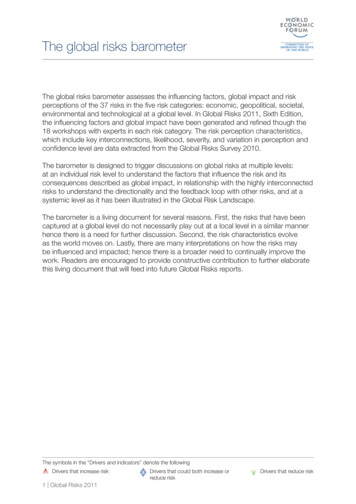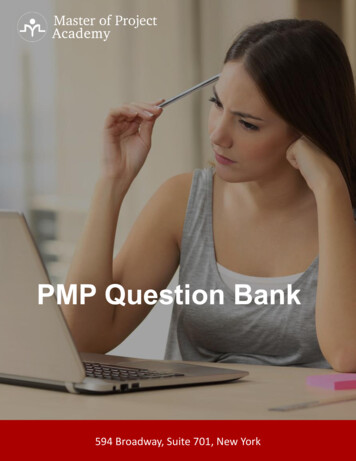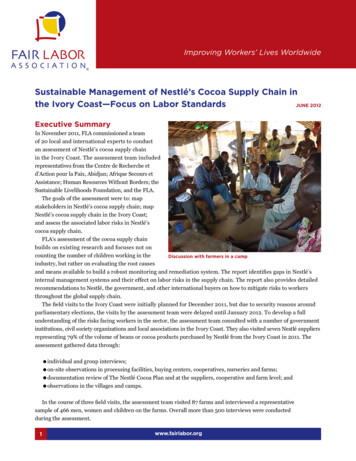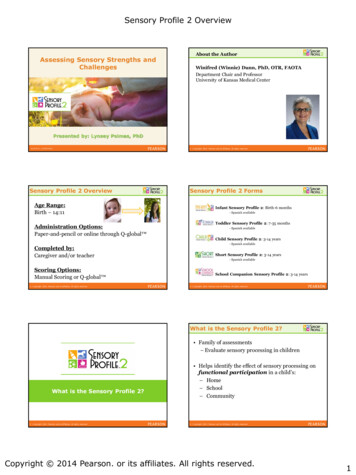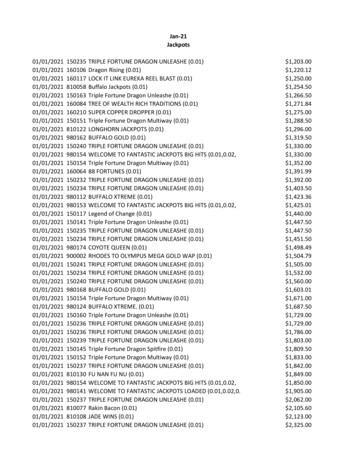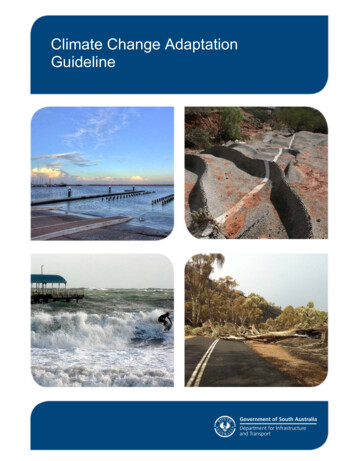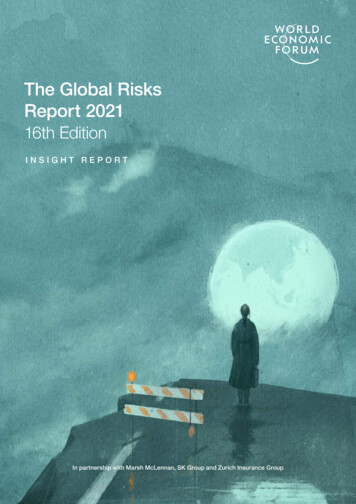
Transcription
The Global RisksReport 202116th EditionINSIGHT REPORTIn partnership with Marsh McLennan, SK Group and Zurich Insurance Group
The Global RisksReport 202116th EditionStrategic PartnersMarsh McLennanSK GroupZurich Insurance GroupAcademic AdvisersNational University of SingaporeOxford Martin School, University of OxfordWharton Risk Management and Decision Processes Center, University of Pennsylvania
The Global Risks Report 2021, 16th Edition,is published by the World Economic Forum.The information in this report, or on whichthis report is based, has been obtainedfrom sources that the authors believeto be reliable and accurate. However, ithas not been independently verified andno representation or warranty, expressor implied, is made as to the accuracyor completeness of any informationobtained from third parties. In addition,the statements in this report may providecurrent expectations of future events basedon certain assumptions and include anystatement that does not directly relate toa historical fact or a current fact. Thesestatements involve known and unknownrisks, uncertainties and other factorswhich are not exhaustive. The companiescontributing to this report operate in acontinually changing environment andnew risks emerge continually. Readersare cautioned not to place undue relianceon these statements. The companiescontributing to this report undertake noobligation to publicly revise or update anystatements, whether as a result of newinformation, future events or otherwise andthey shall in no event be liable for any lossor damage arising in connection with theuse of the information in this report.World Economic Forum Cover artwork: Patrik Svensson 2021 – All rights reserved.All rights reserved. No part of thispublication may be reproduced, storedin a retrieval system, or transmitted, inany form or by any means, electronic,mechanical, photocopying, or otherwisewithout the prior permission of theWorld Economic Forum.ISBN: 978-2-940631-24-7The report and an interactive data platformare available at http://wef.ch/risks2021
ContentsCHAPTER 1PrefaceBy Klaus Schwab andSaadia ZahidiExecutiveSummaryGlobal RisksPerception Survey2020 Results5Global Risks 2021:Fractured Future15CHAPTER 27Error 404: Barriers toDigital Inclusivity2910Postscript: Foresighton Frontier Risks84AppendicesCHAPTER 3Pandemials: Youthin an Age of LostOpportunityHindsight: Reflectionson Responses toCOVID-197239CHAPTER 4Middle Power Morass:Navigating GlobalDivides52Appendix A: Descriptionsof Global Risks 202186Appendix B: Global RisksPerception Survey andMethodology90Acknowledgements 94CHAPTER 5Imperfect Markets: ADisorderly IndustrialShakeout62The Global Risks Report 20214
PrefaceKlaus Schwab, Founder and Executive ChairmanSaadia Zahidi, Managing DirectorIn 2006, the Global Risks Report sounded the alarmon pandemics and other health-related risks. Thatyear, the report warned that a “lethal flu, its spreadfacilitated by global travel patterns and uncontainedby insufficient warning mechanisms, would presentan acute threat.” Impacts would include “severeimpairment of travel, tourism and other serviceindustries, as well as manufacturing and retail supplychains” while “global trade, investor risk appetitesand consumption demand” could see longer-termharms. A year later, the report presented a pandemicscenario that illustrated, among other effects, theamplifying role of “infodemics” in exacerbatingthe core risk. Subsequent editions have stressedthe need for global collaboration in the face ofantimicrobial resistance (8th edition, 2013), the Ebolacrisis (11th edition, 2016), biological threats (14thedition, 2019), and overstretched health systems (15thedition, 2020), among other topics.In 2020, the risk of a global pandemic became reality.As governments, businesses and societies surveythe damage inflicted over the last year, strengtheningstrategic foresight is now more important thanever. With the world more attuned to risk, there isan opportunity to leverage attention and find moreeffective ways to identify and communicate risk todecision-makers.It is in this context that we publish the 16th edition ofthe World Economic Forum’s Global Risks Report.Our analysis centres on the risks and consequencesof widening inequalities and societal fragmentation. Insome cases, disparities in health outcomes, technology,or workforce opportunities are the direct result of thedynamics the pandemic created. In others, alreadypresent societal divisions have widened, straining weaksafety nets and economic structures beyond capacity.Whether the gaps can be narrowed will depend on theactions taken in the wake of COVID-19 to rebuild with aview towards an inclusive and accessible future. Inactionon economic inequalities and societal divisiveness mayfurther stall action on climate change—still an existentialthreat to humanity.Growing societal fragmentation—manifestedthrough persistent and emerging risks to humanhealth, rising unemployment, widening digitaldivides, and youth disillusionment—can have severeconsequences in an era of compounded economic,environmental, geopolitical and technological risks.The gap between the “haves” and “have-nots”will widen further if technology access and abilityremain disparate. The world’s youth have facedexceptional pressures in the past decade and areparticularly vulnerable to missing out altogether onthe opportunities of the next.For business, the economic, technological andreputational pressures of the present moment riska disorderly shakeout, threatening to create a largecohort of workers and companies that are left behindin the markets of the future. Governments, too,must balance between managing the pandemic andeconomic contraction, while at the same time creatingnew opportunities that are fundamental to socialcohesion and the viability of their populations. Mostcritically, if environmental considerations—the toplong-term risks once again—are not confronted in theshort term, environmental degradation will intersectwith societal fragmentation to bring about dramaticconsequences. If managed poorly, these disruptionswill hamper the ability of policy-makers and otherleaders to act on different areas of risk.The Global Risks Report 20215
The foundation of the report continues to be ourannual Global Risks Perception Survey, completed byover 650 members of the World Economic Forum’sdiverse leadership communities. In addition, the longstanding and deeply committed Global Risks AdvisoryBoard shapes the direction of this report from itsearliest stages, and provides insight throughout thewriting process. Over the last year, we have alsoexpanded our efforts around risk and resiliencefor decision-makers and for the broader globalcommunity. A new Global Future Council on FrontierRisks capitalizes on its diverse and forward-lookingmembership to inject fresh thinking into efforts tounderstand and mitigate future risks and to amplifyweak signals of coming disruptions in the decadesahead. Their ideas are featured in the postscript onFrontier Risks. A new Chief Risk Officers communitybrings together leaders in this role in the private sectorand major institutions to share methods and views tocollectively enhance capability.Complementing the Global Risks Practice, the WorldEconomic Forum hosts major platforms dedicatedto action on building a new economy and society,mobilizing for the climate, managing and disseminatingFourth Industrial Revolution technologies, shapingindustry transformations, and enhancing globaland regional cooperation. These platforms, and theleaders, networks and organizations they host, applythe findings of this report in their efforts to tackle theworld’s greatest challenges—managing risks, buildingresilience and leveraging new opportunities. Such anintegrated approach has never been more critical thanat present, as the world moves beyond managing thepandemic to resetting our current systems and buildingback better economies and societies with people andthe planet at the centre of our efforts.We are ever grateful to our long-standing partners inthe report’s development, Marsh McLennan and ZurichInsurance Group. We welcomed a new partner thisyear, SK Group, to whom we owe a debt of gratitudefor the valuable inputs provided. We are also gratefulto our academic partners: the National University ofSingapore, the Oxford Martin School at the Universityof Oxford, and the Wharton Risk Management andDecision Processes Center at the University ofPennsylvania. Insights from a wide set of experts fromthe public and private sectors can also be found inthese pages.The Global Risks Report 20216
Executive SummaryThe immediate human and economic cost of COVID-19is severe. It threatens to scale back years of progresson reducing poverty and inequality and to furtherweaken social cohesion and global cooperation. Joblosses, a widening digital divide, disrupted socialinteractions, and abrupt shifts in markets could leadto dire consequences and lost opportunities for largeparts of the global population. The ramifications—inthe form of social unrest, political fragmentation andgeopolitical tensions—will shape the effectiveness of ourresponses to the other key threats of the next decade:cyberattacks, weapons of mass destruction and, mostnotably, climate change.In the Global Risks Report 2021, we share the resultsof the latest Global Risks Perception Survey (GRPS),followed by analysis of growing social, economic andindustrial divisions, their interconnections, and theirimplications on our ability to resolve major global risksrequiring societal cohesion and global cooperation.We conclude the report with proposals for enhancingresilience, drawing from the lessons of the pandemicas well as historical risk analysis. The key findings ofthe survey and the analysis are included below.Global risks perceptionsAmong the highest likelihood risks of the next tenyears are extreme weather, climate action failureand human-led environmental damage; as well asdigital power concentration, digital inequality andcybersecurity failure. Among the highest impact risksof the next decade, infectious diseases are in thetop spot, followed by climate action failure and otherenvironmental risks; as well as weapons of massdestruction, livelihood crises, debt crises andIT infrastructure breakdown.When it comes to the time-horizon within which these riskswill become a critical threat to the world, the most imminentthreats – those that are most likely in the next two years– include employment and livelihood crises, widespreadyouth disillusionment, digital inequality, economicstagnation, human-made environmental damage,erosion of societal cohesion, and terrorist attacks.Economic risks feature prominently in the 3-5 yeartimeframe, including asset bubbles, price instability,commodity shocks and debt crises; followed bygeopolitical risks, including interstate relations andconflict, and resource geopolitization. In the 5-10year horizon, environmental risks such as biodiversityloss, natural resource crises and climate action failuredominate; alongside weapons of mass destruction,adverse effects of technology and collapse of states ormultilateral institutions.Economic fragility and societaldivisions are set to increaseUnderlying disparities in healthcare, education,financial stability and technology have led the crisisto disproportionately impact certain groups andcountries. Not only has COVID-19 caused more thantwo million deaths at the time of writing, but theeconomic and long-term health impacts will continueto have devastating consequences. The pandemic’seconomic shockwave—working hours equivalentto 495 million jobs were lost in the second quarterof 2020 alone—will immediately increase inequality,but so can an uneven recovery. Only 28 economiesare expected to have grown in 2020. Nearly 60%of respondents to the GRPS identified “infectiousdiseases” and “livelihood crises” as the top short-termthreats to the world. Loss of lives and livelihoods willincrease the risk of “social cohesion erosion”, also acritical short-term threat identified in the GRPS.Growing digital divides andtechnology adoption pose concernsCOVID-19 has accelerated the Fourth IndustrialRevolution, expanding the digitalization of humanThe Global Risks Report 20217
interaction, e-commerce, online education and remotework. These shifts will transform society long afterthe pandemic and promise huge benefits—the abilityto telework and rapid vaccine development are twoexamples—but they also risk exacerbating and creatinginequalities. Respondents to the GRPS rated “digitalinequality” as a critical short-term threat.A widening digital gap can worsen societal fracturesand undermine prospects for an inclusive recovery.Progress towards digital inclusivity is threatened bygrowing digital dependency, rapidly acceleratingautomation, information suppression and manipulation,gaps in technology regulation and gaps in technologyskills and capabilities.According to the GRPS, the risk of “youthdisillusionment” is being largely neglected by the globalcommunity, but it will become a critical threat to theworld in the short term. Hard-fought societal winscould be obliterated if the current generation lacksadequate pathways to future opportunities—and losesfaith in today’s economic and political institutions.Climate continues to be a loomingrisk as global cooperation weakensA doubly disrupted generation ofyouth is emerging in an age of lostopportunityClimate change—to which no one is immune—continuesto be a catastrophic risk. Although lockdowns worldwidecaused global emissions to fall in the first half of 2020,evidence from the 2008–2009 Financial Crisis warnsthat emissions could bounce back. A shift towardsgreener economies cannot be delayed until the shocksof the pandemic subside. “Climate action failure” is themost impactful and second most likely long-term riskidentified in the GRPS.While the digital leap forward unlocked opportunitiesfor some youth, many are now entering the workforcein an employment ice age. Young adults worldwideare experiencing their second major global crisis in adecade. Already exposed to environmental degradation,the consequences of the financial crisis, rising inequality,and disruption from industrial transformation, thisgeneration faces serious challenges to their education,economic prospects and mental health.Responses to the pandemic have caused new domesticand geopolitical tensions that threaten stability. Digitaldivision and a future “lost generation” are likely to testsocial cohesion from within borders—exacerbatinggeopolitical fragmentation and global economicfragility. With stalemates and flashpoints increasing infrequency, GRPS respondents rated “state collapse” and“multilateralism collapse” as critical long-term threats.REUTERS/ISMAILThe Global Risks Report 20218
Middle powers—influential states that togetherrepresent a greater share of the global economythan the US and China combined—often championmultilateral cooperation in trade, diplomacy, climate,security and, most recently, global health. However,if geopolitical tensions persist, middle powers willstruggle to facilitate a global recovery—at a timewhen international coordination is essential—andreinforce resilience against future crises. GRPSrespondents signal a challenging geopolitical outlookmarked by “interstate relations fracture”, “interstateconflict” and “resource geopolitization”—allforecasted as critical threats to the world in threeto five years.A polarized industriallandscape may emerge in thepost-pandemic economyAs economies emerge from the shock and stimulusof COVID-19, businesses face a shakeout. Existingtrends have been given fresh momentum by the crisis:nationally focused agendas to stem economic losses,technological transformation and changes in societalstructure—including consumer behaviors, the natureof work and the role of technology both at work andat home. The business risks emanating from thesetrends have been amplified by the crisis and includestagnation in advanced economies and lost potentialin emerging and developing markets, the collapseof small businesses, widening the gaps betweenmajor and minor companies and reducing marketdynamism, and exacerbation of inequality; making itharder to achieve long-term sustainable development.With governments still deliberating how to pivot awayfrom emergency to recovery, and with companiesanticipating a changed business landscape, there areopportunities to invest in smart, clean and inclusivegrowth that will improve productivity and delivery ofsustainable agendas.Better pathways are available tomanage risks and enhance resilienceDespite some remarkable examples of determination,cooperation and innovation, most countries havestruggled with aspects of crisis management duringthe global pandemic. While it is early to draw definitivelessons, this edition of the Global Risks Report reflectson global preparedness by looking at four key areas ofthe response to COVID-19: institutional authority, riskfinancing, information collection and sharing,and equipment and vaccines. It then looks to nationallevel responses—acknowledging the varied startingpoints for individual countries—and draws lessonsfrom five domains: government decision-making,public communication, health system capabilities,lockdown management and financial assistance tothe vulnerable.However, if lessons from this crisis only informdecision-makers how to better prepare for the nextpandemic—rather than enhancing risk processes,capabilities and culture—the world will be againplanning for the last crisis rather than anticipatingthe next. The response to COVID-19 offers fourgovernance opportunities to strengthen the overallresilience of countries, businesses and the internationalcommunity: (1) formulating analytical frameworksthat take a holistic and systems-based view of riskimpacts; (2) investing in high-profile “risk champions”to encourage national leadership and internationalco-operation; (3) improving risk communications andcombating misinformation; and (4) exploring new formsof public-private partnership on risk preparedness.The Global Risks Report 20219
Global RisksPerceptionSurvey 2020ResultsREUTERS/GAILLARDThe Global Risks Report 202110
FIGUREI IFIGUREGlobal RisksRisks HorizonHorizonWhen do respondents forecast risks will become a critical threat to the hnological% of respondentsInfectious diseases58.0Livelihood crises55.1Extreme weather events52.7Cybersecurity failure39.0Digital inequality38.3Prolonged stagnation38.3Terrorist attacks37.8Youth disillusionment36.4Social cohesion erosion35.6Human environmental damage35.6Asset bubble burst53.3IT infrastructure breakdown53.3Price instability52.9Commodity shocks52.7Knock-oneffectsDebt crises52.3Medium-termrisks (3 – 5 years)Interstate relations fracture50.7Interstate conflict49.5Cybersecurity failure49.0Tech governance failure48.1Resource geopolitization47.9Weapons of mass destruction62.7State collapse51.8Biodiversity loss51.2Adverse tech advances50.2ExistentialthreatsNatural resource crises43.9Long-term risks(5 – 10 years)Social security collapse43.4Multilateralism collapse39.8Industry collapse39.7Clear andpresentdangersShort-term risks(0 – 2 years)Climate action failure38.3Backlash against science37.8Source: World Economic Forum Global Risks Perception Survey 2020The Global Risks Report 202111
pe 2021 TheRisks Landscape 2021F I G U RGlobalE IIe impact andHowlikelihooddo survey respondentsof globalrisks?perceive the impact and likelihood of global risks?GlobalRisksLandscapeThe Global Risks Landscape 2021Howsurvey respondentsthe impact and likelihood ofrisks?global risks?Howdo dorespondentsperceive perceivethe impactand likelihoodof globalInfectious diseasesInfectious diseasesClimate action failureClimate action failureInfectious diseases4Climate action failureWeapons of mass destruction4Weapons of mass destructionBiodiversity lossNatural resource crisesBiodiversity lossNatural resource crisesHuman environmental damageBiodiversity lossNatural resource crisesLivelihood crisesDebt crisese conflictProlongedstagnation3.5Social security collapse3.5AverageAsset bubble burstPublicinfrastructurefailuresm collapseBacklash against scienceTech governance failurePrice instabilityPrice instabilityInvoluntary ncentrationAsset bubble burstDigital power concentrationResource geopolitizationAsset bubble refailureState collapseState collapseAdverse tech advancesCommodity shocksResource geopolitizationYouth disillusionmentYouth disillusionmentGeophysical disastersGeophysical disastersAdverse tech advancesCommodity shocksTech governance failureDigital inequalityMultilateralism collapse Tech governance failureMultilateralism collapseIndustry collapseDigital inequalityDigital inequalityIndustry collapse3Mental health deteriorationImpact Social cohesion erosionInterstate relations fractureResource geopolitizationGeophysical disastersBacklash against science3Mental health deteriorationMental health deteriorationTerrorist attacksImpact mic activityProlongedstagnationInvoluntary migrationDigital power concentrationYouth disillusionmenttech advancesInterstate conflictExtreme weatherSocialcohesion erosionCybersecurityfailureInterstate relations fracture3.40 Average3.40ProlongedstagnationInvoluntary migration Social security collapseExtreme weatherCybersecurity failureLivelihood crisesDebt crisesInterstate conflictSocial cohesion erosionIT infrastructure breakdownHuman environmental damageLivelihood crisesDebt crisesExtreme weatherCybersecurityfailurebreakdownIT infrastructureHuman environmental damageTerrorist attacksTerrorist attacksIllicit economic activityIllicit economic activity3.52.52.5AverageLikelihood geAverage3.283.28MethodologyRisk categoriesMethodologyTop Risks5 5by likelihoodEconomicsked to assess the likelihood of the individual skedtotoassessassessthethelikelihoodlikelihoodof thethe individualindividualglobala scale1 torepresentingaariskriskthatthat isis veryvery unlikelyunlikely to5, 1 representing a risk that is very unlikely to globalriskriskon ona scaleof of1 to5,5,1 1representingtoEnvironmentalhappena hecoursenextery likely to occur over the course of the next tenhappenandand5 a5riskthatis isveryof thenext tenten1 acheachglobalglobalriskrisk onon aa scale ofGeopoliticalhe impact of each global risk on a scale of 1 toyears.5, years.Theyalsoassessedtheimpactof 11 toto 5,5,Climateaction failure1 representinga minimalimpactandand5 5a acatastrophiccatastrophic2impact.impact.To ensureensurepact and 5 a catastrophic impact. To ensure 1 representinga risksareareabbreviated.abbreviated.lobal risks are abbreviated.legibility,thethenamesof ofthetheglobal3Human environmental damage1 15 5Technological44Top conomicEnvironmentalEnvironmentalInfectious diseasesGeopoliticalGeopoliticalClimate action failureSocietalSocietalWeapons of mass destructionTechnologicalTechnological4Infectious diseasesBiodiversity loss5Biodiversity lossNatural resource crisesSurvey respondents were asked to assess the likelihood of the individualglobal risk on a scale of 1 to 5, 1 representing a risk that is very unlikelyand 5 a risk that is very likely to occur over the course of the next tenyears. They also assessed the impact of each global risk on a scale of1 to 5, 1 representing a minimal impact and 5 a catastrophic impact. Toensure legibility,the names of the global risks are abbreviated.6Digital power concentrationHuman environmental damage7Digital inequalityLivelihood crises8Interstate relations fractureExtreme weather9Cybersecurity failureDebt crisesSource: World Economic Forum Global Risks Perception Survey 202010Livelihood crisesIT infrastructure breakdownMethodologySource: World Economic Forum Global Risks Perception Survey 2020eption Survey 2020Source: World Economic Forum Global Risks Perception Survey 2020Source: World Economic ForumGlobal Risks Perception Survey 2020Source: World Economic ForumGlobal Risks Perception Survey 2020The Global Risks Report 202112
FIGURE IIIGlobal Risks NetworkWhat drives global risks?Respondents rank the most concerning risks globally and their drivers.8th6th4th2nd1st3rd5th7th9 edAsset BubbleDisillusionment StagnationBurstSocial xtremeWeatherSocial CohesionErosionMultilateralismCollapseAdverseTech AdvancesClimate oluntaryMigration1stDigital PowerConcentration2ndResourceGeopolitilization3 eBreakdown7th6 thHumanEnvironmentalDamage9 th8thOuter Arc DriversInner Arc RisksEconomicEnvironmentalLine Thickness Strength of CausalityGeopoliticalSocietalTechnology- Survey respondents were asked to rank order the three risks they considerto be the most concerning for the world. Respondents were then asked toselect up to five risks they consider will be driving their top concerns overthe course of the next 10 years, with no particular ordering. See AppendixB for more details. To ensure legibility, the names of the global risks areabbreviated; see Appendix A for full names and descriptions. Read moreabout the s-report-2021/methodologyVisit https://www.weforum.org/global-risks toexplore the Global Risks Network interactive graphicSource: World Economic Forum Global Risks Perception Survey 2020The Global Risks Report 202113
FIGUREF I G U R EIV I VEvolvingRisksLandscapeLandscapeEvolving RisksTop Global Risks by Likelihood1st2ndClimate ous mate actionfailureNaturaldisastersBiodiversity therClimate actionfailureNaturaldisastersData fraudor sCyberattacksData fraudor theftClimate nNaturaldisastersTerroristattacksData fraudor theft2016InvoluntarymigrationExtremeweatherClimate 2015InterstateconflictExtremeweatherFailure of nationalgovernanceState collapseor rUnemploymentClimate actionfailureCyberattacksIncome disparityFiscalimbalancesGreenhousegas emissionsWater crisesPopulationageingIncome disparityFiscalimbalancesGreenhouse gasemissionsCyberattacksWater crises1st201320122nd3rdBiodiversity loss4th6thDigital powerconcentration7thDigital inequality5thTop Global Risks by Impact1st2ndClimate actionfailure3rdWeapons ofmass destruction4thBiodiversity loss5th2021Infectiousdiseases2020Climate actionfailureWeapons ofmass destructionBiodiversity lossExtremeweatherWater crises2019Weapons ofmass destructionClimate actionfailureExtremeweatherWater crisesNaturaldisasters2018Weapons ofmass destructionExtremeweatherNaturaldisastersClimate actionfailureWater crises2017Weapons ofmass destructionExtremeweatherWater crisesNaturaldisastersClimate actionfailure2016Climate actionfailureWeapons ofmass destructionWater crisesInvoluntarymigrationEnergy priceshockWater crisesInfectiousdiseasesWeapons ofmass destructionInterstateconflictClimate actionfailureFiscal crisesClimate actionfailureWater crisesUnemploymentInfrastructurebreakdownFinancial failureWater crisesFiscalimbalancesWeapons ofmass destructionClimate actionfailureFinancial failureWater crisesFood crisesFiscalimbalancesEnergyprice tal3rdGeopoliticalNatural ge7thLivelihood crises5thTechnologicalSource: World Economic Forum Global Risks Perception Survey 2020The Global Risks Report 202114
CHAPTER 1Global Risks2021: FracturedFutureREUTERS/CABEZASThe Global Risks Report 202115
The immediate human and economiccosts of COVID-19 are severe. Theythreaten to scale back years of progresson reducing global poverty and inequalityand further damage social cohesion andglobal cooperation, which were alreadyweakening before the virus struck.New barriers to individual and collectiveadvancement will likely result from thepandemic as the world faces the suddendisruption of social interactions, a wideningdigital divide, abrupt shifts in markets andconsumer behaviour, loss of education andjobs, and challenges to democracy andinternational relations. “Digital inequality”,“youth disillusionment” and “socialcohesion erosion”—newly included in theGlobal Risks Perception Survey (GRPS)—were all identified by respondents as criticalshort-term threats.Structural fissuresexacerbated by the crisisthreaten to make therecovery deeply unevenA digital leap forward—disrupting industry,education, labour markets, and thebalance of power between nations—risks widening the gap between thetechnological “haves” and “have-nots”.All generations and groups have beenaffected by the crisis: older populationsare the most vulnerable to the pandemicitself, and youth face new barriers tosocial mobility, strains on mental health,uncertain economic prospects and thecontinued degradation of the planet.Climate change—to which no one isimmune, nor can the world vaccinateagainst it—continues to be catastrophic:“climate action failure” is the mostimpactful and second most likely longterm r
Dec 20, 2020 · The Global Risks Report 2021, 16th Edition, is published by the World Economic Forum. The
